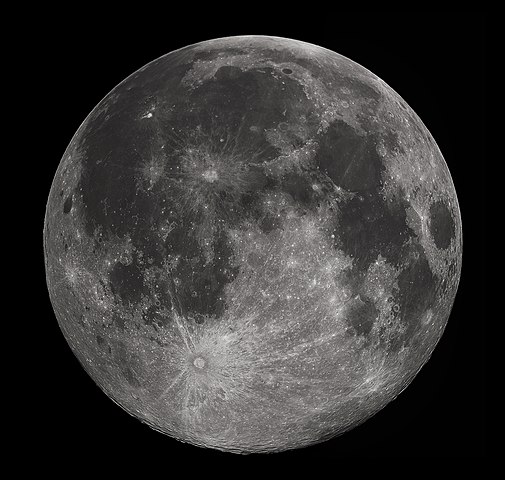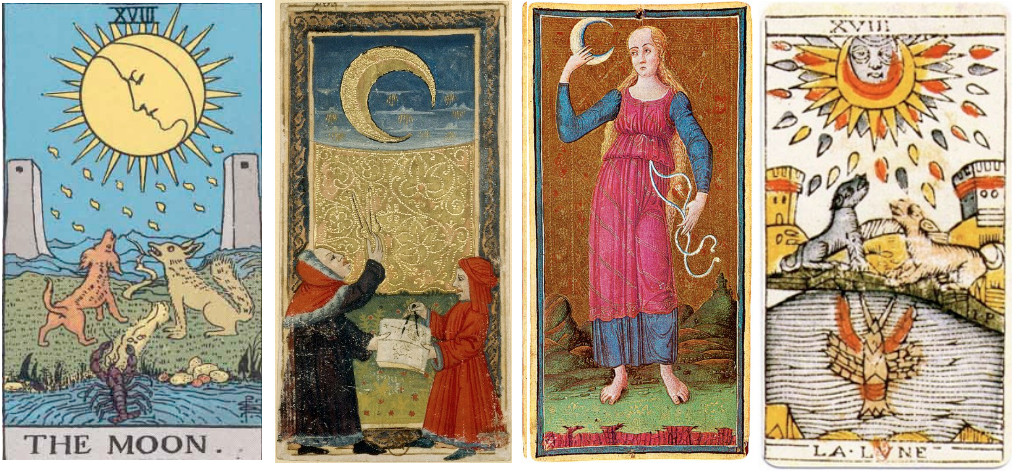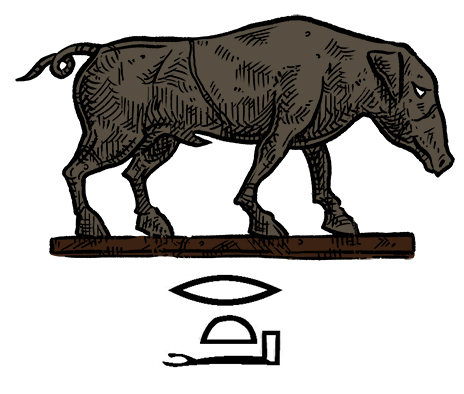Difference between revisions of "Moon"
Occultwiki (talk | contribs) |
Occultwiki (talk | contribs) |
||
| (5 intermediate revisions by the same user not shown) | |||
| Line 24: | Line 24: | ||
Astrologically, the moon rules over the sign of [[Cancer]] and represents the most peaceful elements of human nature. It can indicate our subconscious world, our emotions, and the love we are capable of feeling, even though it may not be outwardly expressed. | Astrologically, the moon rules over the sign of [[Cancer]] and represents the most peaceful elements of human nature. It can indicate our subconscious world, our emotions, and the love we are capable of feeling, even though it may not be outwardly expressed. | ||
[[ | ===Lunar station=== | ||
Often called "[[lunar mansion]]", a lunar station or lunar house is a segment of the ecliptic through which the Moon passes in its orbit around the [[Earth]]. The concept was used by several ancient cultures as part of their calendrical system. | |||
==Mythology== | ==Mythology== | ||
Iconographically the crescent was used in Mesopotamia as the primary symbol of Nanna/Sîn, the ancient Sumerian lunar deity, who was the father of Innana/[[Ishtar]], the goddess of the planet [[Venus]] (symbolized as the eight pointed Star of Ishtar), and Utu/Shamash, the god of the Sun (symbolized as a disc, optionally with eight rays), all three often depicted next to each other. Nanna was later known as Sîn, and was particularly associated with magic and sorcery. | Iconographically the crescent was used in Mesopotamia as the primary symbol of Nanna/Sîn, the ancient Sumerian lunar deity, who was the father of Innana/[[Ishtar]], the goddess of the planet [[Venus]] (symbolized as the eight pointed Star of Ishtar), and Utu/Shamash, the god of the Sun (symbolized as a disc, optionally with eight rays), all three often depicted next to each other. Nanna was later known as Sîn, and was particularly associated with magic and sorcery. | ||
The crescent was further used as an element of lunar deities wearing headgears or crowns in an arrangement reminiscent of horns, as in the case of the ancient Greek Selene or the ancient Egyptian Khonsu. Selene is associated with Artemis and paralleled by the Roman Luna, which both are occasionally depicted driving a chariot, like the Hindu lunar deity Chandra. The different or sharing aspects of deities within pantheons has been observed in many cultures, especially by later or contemporary culture, particularly forming triple deities. | The crescent was further used as an element of lunar deities wearing headgears or crowns in an arrangement reminiscent of horns, as in the case of the ancient Greek Selene or the ancient Egyptian Khonsu. Selene is associated with Artemis and paralleled by the Roman Luna, which both are occasionally depicted driving a chariot, like the [[Hindu]] lunar deity Chandra. The different or sharing aspects of deities within pantheons has been observed in many cultures, especially by later or contemporary culture, particularly forming triple deities. | ||
The Moon in Roman mythology for example has been associated with Juno and Diana, while Luna being identified as their byname and as part of a triplet (''diva triformis'') with Diana and Proserpina, Hecate being identified as their binding manifestation as trimorphos. | The Moon in Roman mythology for example has been associated with Juno and Diana, while Luna being identified as their byname and as part of a triplet (''diva triformis'') with Diana and Proserpina, [[Hecate]] being identified as their binding manifestation as trimorphos. | ||
The star and crescent (☪️) arrangement goes back to the Bronze Age, representing either the Sun and Moon, or the Moon and planet Venus, in combination. It came to represent the goddess Artemis or Hecate, and via the patronage of Hecate came to be used as a symbol of Byzantium, possibly influencing the development of the Ottoman flag, specifically the combination of the Turkish crescent with a star. Since then the | The star and crescent (☪️) arrangement goes back to the Bronze Age, representing either the Sun and Moon, or the Moon and planet Venus, in combination. It came to represent the goddess Artemis or Hecate, and via the patronage of [[Hecate]] came to be used as a symbol of Byzantium, possibly influencing the development of the Ottoman flag, specifically the combination of the Turkish crescent with a star. Since then the heraldic use of the star and crescent proliferated becoming a popular symbol for [[Islam]] (as the hilal of the Islamic calendar) and for a range of nations. | ||
The [[Olympic spirit]] [[Phul]] rules over the moon. | |||
In the [[Kabbalah]], the moon is associated with the [[sefirot]] of [[Yesod]] and its opposing [[qlippoth]], [[Gamaliel]]. | |||
[[The Moon]] is the 18th [[Tarot]] card in most traditional decks. It indicates hidden enemies, danger, uncertainty, and darkness. | |||
===Egyptian religion=== | ===Egyptian religion=== | ||
| Line 45: | Line 48: | ||
The left eye of [[Horus]] was seen by Egyptians as the moon and its phases mimicked the loss and eventual restoration of Horus' eye during his long battles with [[Set]]. There was also a legend stating that Set transformed himself into a black pig and caused further injury to Horus' eye. This has been interpreted as the new moon, during which the sky is dark compared to the full moon, when the sky is illuminated. | The left eye of [[Horus]] was seen by Egyptians as the moon and its phases mimicked the loss and eventual restoration of Horus' eye during his long battles with [[Set]]. There was also a legend stating that Set transformed himself into a black pig and caused further injury to Horus' eye. This has been interpreted as the new moon, during which the sky is dark compared to the full moon, when the sky is illuminated. | ||
On the ceiling of the Temple of Hathor at Dendera, there is a diagram showing the phases of the moon as a stylized eye of Horus. This same ceiling contains a depiction of the [[Egyptian decans|Egyptian decan]] [[Aryt]] as a black Set-pig. | On the ceiling of the Temple of [[Hathor]] at Dendera, there is a diagram showing the phases of the moon as a stylized eye of Horus. This same ceiling contains a depiction of the [[Egyptian decans|Egyptian decan]] [[Aryt]] as a black [[Set]]-pig. | ||
==Eclipses== | ==Eclipses== | ||
Latest revision as of 18:06, 19 December 2024
The Moon is Earth's only natural satellite. It is the fifth largest satellite in the Solar System and the largest and most massive relative to its parent planet, with a diameter about one-quarter that of Earth (comparable to the width of Australia). The Moon is a planetary-mass object with a differentiated rocky body, making it a satellite planet under the geophysical definitions of the term and larger than all known dwarf planets of the Solar System.
In Western alchemy, silver is associated with the Moon, and gold with the Sun.
Name
The usual English proper name for Earth's natural satellite is simply "Moon," with a capital M. The noun moon is derived from Old English mōna, which (like all its Germanic cognates) stems from Proto-Germanic *mēnōn, which in turn comes from Proto-Indo-European *mēnsis "month" (from earlier *mēnōt, genitive *mēneses) which may be related to the verb "measure" (of time).
Occasionally, the name Luna /ˈluːnə/ is used in scientific writing and especially in science fiction to distinguish the Earth's moon from others, while in poetry "Luna" has been used to denote personification of the Moon. Cynthia /ˈsɪnθiə/ is another poetic name, though rare, for the Moon personified as a goddess, while Selene /səˈliːniː/ (literally "Moon") is the Greek goddess of the Moon.
The astronomical symbol for the Moon is a crescent, ☾. For the representation of the Moon, especially its lunar phases, the crescent symbol (🌙) has been particularly used by many cultures. In writing systems such as Chinese the crescent has developed into the symbol 月, the word for Moon, and in ancient Egyptian it was the symbol 𓇹, which is spelled like the ancient Egyptian lunar deity Iah, meaning Moon.
Formation
Isotope dating of lunar samples suggests the Moon formed around 50 million years after the origin of the Solar System. Historically, several formation mechanisms have been proposed, but none satisfactorily explains the features of the Earth–Moon system. A fission of the Moon from Earth's crust through centrifugal force would require too great an initial rotation rate of Earth. Gravitational capture of a pre-formed Moon depends on an unfeasibly extended atmosphere of Earth to dissipate the energy of the passing Moon. A co-formation of Earth and the Moon together in the primordial accretion disk does not explain the depletion of metals in the Moon. None of these hypotheses can account for the high angular momentum of the Earth–Moon system.
The prevailing theory is that the Earth–Moon system formed after a giant impact of a Mars-sized body (named Theia) with the proto-Earth.
Astrology
Since prehistoric and ancient times humans have depicted and interpreted the Moon, particularly for astrology and religion, as lunar deity.
Eastern Astrology considers the moon to be the most important entity in astrological and horoscope interpretation because it represents the human soul and our inner emotional world.
Astrologically, the moon rules over the sign of Cancer and represents the most peaceful elements of human nature. It can indicate our subconscious world, our emotions, and the love we are capable of feeling, even though it may not be outwardly expressed.
Lunar station
Often called "lunar mansion", a lunar station or lunar house is a segment of the ecliptic through which the Moon passes in its orbit around the Earth. The concept was used by several ancient cultures as part of their calendrical system.
Mythology
Iconographically the crescent was used in Mesopotamia as the primary symbol of Nanna/Sîn, the ancient Sumerian lunar deity, who was the father of Innana/Ishtar, the goddess of the planet Venus (symbolized as the eight pointed Star of Ishtar), and Utu/Shamash, the god of the Sun (symbolized as a disc, optionally with eight rays), all three often depicted next to each other. Nanna was later known as Sîn, and was particularly associated with magic and sorcery.
The crescent was further used as an element of lunar deities wearing headgears or crowns in an arrangement reminiscent of horns, as in the case of the ancient Greek Selene or the ancient Egyptian Khonsu. Selene is associated with Artemis and paralleled by the Roman Luna, which both are occasionally depicted driving a chariot, like the Hindu lunar deity Chandra. The different or sharing aspects of deities within pantheons has been observed in many cultures, especially by later or contemporary culture, particularly forming triple deities.
The Moon in Roman mythology for example has been associated with Juno and Diana, while Luna being identified as their byname and as part of a triplet (diva triformis) with Diana and Proserpina, Hecate being identified as their binding manifestation as trimorphos.
The star and crescent (☪️) arrangement goes back to the Bronze Age, representing either the Sun and Moon, or the Moon and planet Venus, in combination. It came to represent the goddess Artemis or Hecate, and via the patronage of Hecate came to be used as a symbol of Byzantium, possibly influencing the development of the Ottoman flag, specifically the combination of the Turkish crescent with a star. Since then the heraldic use of the star and crescent proliferated becoming a popular symbol for Islam (as the hilal of the Islamic calendar) and for a range of nations.
The Olympic spirit Phul rules over the moon.
In the Kabbalah, the moon is associated with the sefirot of Yesod and its opposing qlippoth, Gamaliel.
The Moon is the 18th Tarot card in most traditional decks. It indicates hidden enemies, danger, uncertainty, and darkness.
Egyptian religion
An association of time with the Moon can also be found in religion, such as the ancient Egyptian temporal and lunar deity Khonsu.
The left eye of Horus was seen by Egyptians as the moon and its phases mimicked the loss and eventual restoration of Horus' eye during his long battles with Set. There was also a legend stating that Set transformed himself into a black pig and caused further injury to Horus' eye. This has been interpreted as the new moon, during which the sky is dark compared to the full moon, when the sky is illuminated.
On the ceiling of the Temple of Hathor at Dendera, there is a diagram showing the phases of the moon as a stylized eye of Horus. This same ceiling contains a depiction of the Egyptian decan Aryt as a black Set-pig.
Eclipses
Eclipses only occur when the Sun, Earth, and Moon are all in a straight line (termed "syzygy"). Solar eclipses occur at new moon, when the Moon is between the Sun and Earth. In contrast, lunar eclipses occur at full moon, when Earth is between the Sun and Moon. The apparent size of the Moon is roughly the same as that of the Sun, with both being viewed at close to one-half a degree wide.
The Sun is much larger than the Moon but it is the vastly greater distance that gives it the same apparent size as the much closer and much smaller Moon from the perspective of Earth. The variations in apparent size, due to the non-circular orbits, are nearly the same as well, though occurring in different cycles. This makes possible both total (with the Moon appearing larger than the Sun) and annular (with the Moon appearing smaller than the Sun) solar eclipses. In a total eclipse, the Moon completely covers the disc of the Sun and the solar corona becomes visible to the naked eye. Because the distance between the Moon and Earth is very slowly increasing over time, the angular diameter of the Moon is decreasing. As it evolves toward becoming a red giant, the size of the Sun, and its apparent diameter in the sky, are slowly increasing. The combination of these two changes means that hundreds of millions of years ago, the Moon would always completely cover the Sun on solar eclipses, and no annular eclipses were possible. Likewise, hundreds of millions of years in the future, the Moon will no longer cover the Sun completely, and total solar eclipses will not occur.
Because the Moon's orbit around Earth is inclined by about 5.145° (5° 9') to the orbit of Earth around the Sun, eclipses do not occur at every full and new moon. For an eclipse to occur, the Moon must be near the intersection of the two orbital planes. The periodicity and recurrence of eclipses of the Sun by the Moon, and of the Moon by Earth, is described by the saros, which has a period of approximately 18 years.
Because the Moon continuously blocks the view of a half-degree-wide circular area of the sky, the related phenomenon of occultation occurs when a bright star or planet passes behind the Moon and is occulted: hidden from view. In this way, a solar eclipse is an occultation of the Sun. Because the Moon is comparatively close to Earth, occultations of individual stars are not visible everywhere on the planet, nor at the same time. Because of the precession of the lunar orbit, each year different stars are occulted.
Lunar calendar
Since pre-historic times people have taken note of the Moon's phases, its waxing and waning, and used it to keep record of time. Tally sticks, notched bones dating as far back as 20–30,000 years ago, are believed by some to mark the phases of the Moon. The counting of the days between the Moon's phases gave eventually rise to generalized time periods of the full lunar cycle as months, and possibly of its phases as weeks.
The Egyptian calendar originally incorporated aspects of the lunar cycle, but these were later kept as a separate calendar for specific religious celebrations and rituals.
Since each lunation is approximately 29+1⁄2 days, it is common for the months of a lunar calendar to alternate between 29 and 30 days. Since the period of 12 such lunations, a lunar year, is 354 days, 8 hours, 48 minutes, 34 seconds (354.36707 days), purely lunar calendars are 11 to 12 days shorter than the solar year. In purely lunar calendars, which do not make use of intercalation, the lunar months cycle through all the seasons of a solar year over the course of a 33–34 lunar-year cycle.
This lunar timekeeping gave rise to the historically dominant, but varied, lunisolar calendars. The 7th-century Islamic calendar is an example of a purely lunar calendar, where months are traditionally determined by the visual sighting of the hilal, or earliest crescent moon, over the horizon.
Of particular significance has been the occasion of full moon, highlighted and celebrated in a range of calendars and cultures. Around autumnal equinox, the Full Moon is called the Harvest Moon and is celebrated with festivities such as the Harvest Moon Festival of the Chinese Lunar Calendar, its second most important celebration after Chinese New Year.
Lunar effect
The lunar effect is a purported unproven correlation between specific stages of the roughly 29.5-day lunar cycle and behavior and physiological changes in living beings on Earth, including humans. The Moon has long been associated with insanity and irrationality; the words lunacy and lunatic are derived from the Latin name for the Moon, Luna.
Philosophers Aristotle and Pliny the Elder argued that the full moon induced insanity in susceptible individuals, believing that the brain, which is mostly water, must be affected by the Moon and its power over the tides, but the Moon's gravity is too slight to affect any single person. Even today, people who believe in a lunar effect claim that admissions to psychiatric hospitals, traffic accidents, homicides or suicides increase during a full moon, but dozens of studies invalidate these claims.


